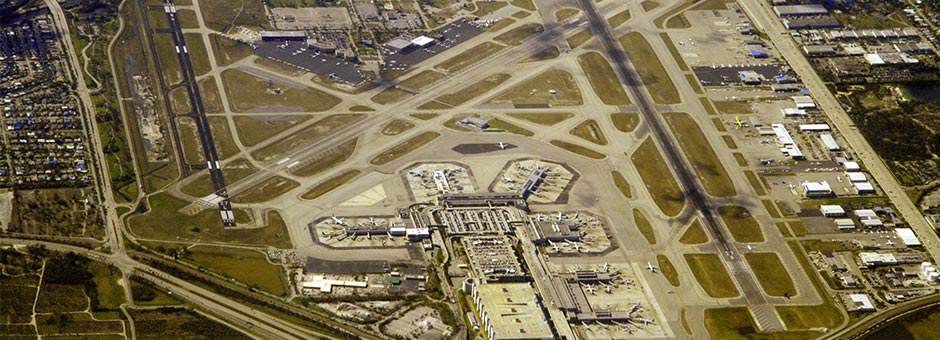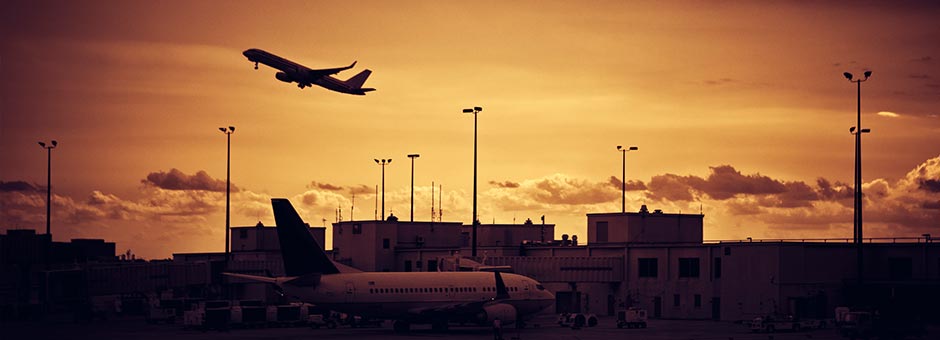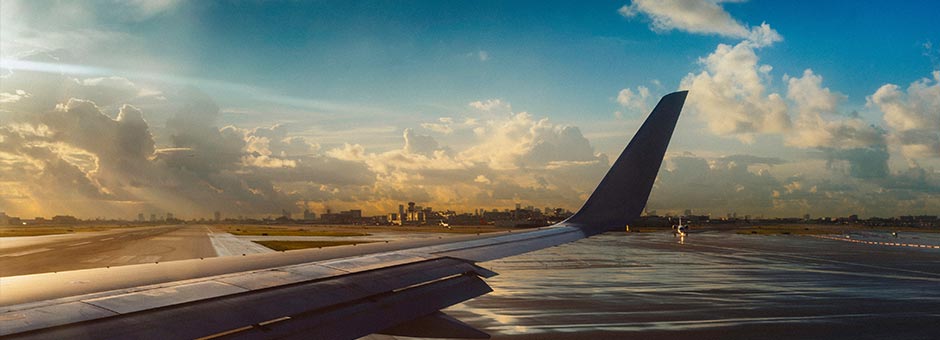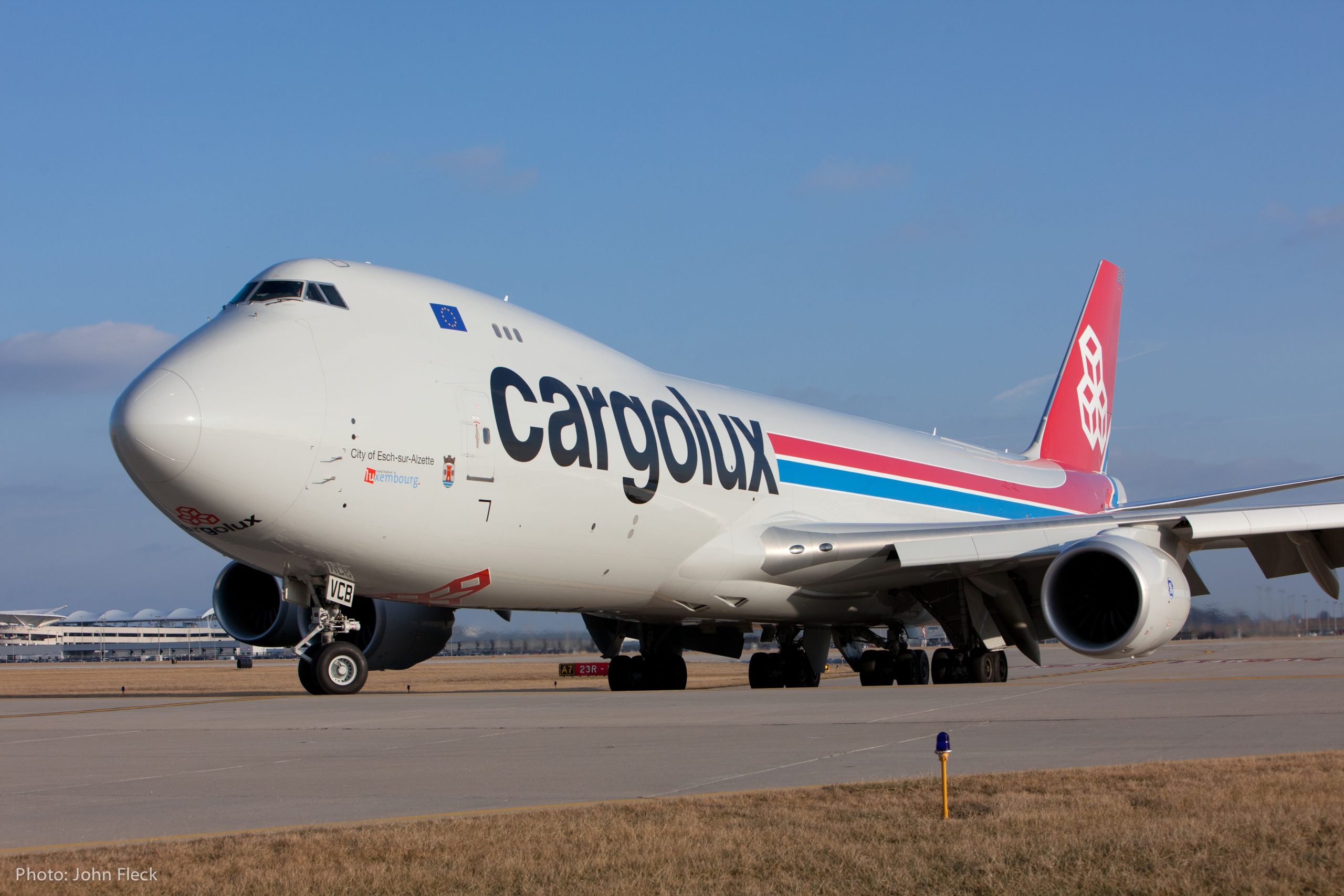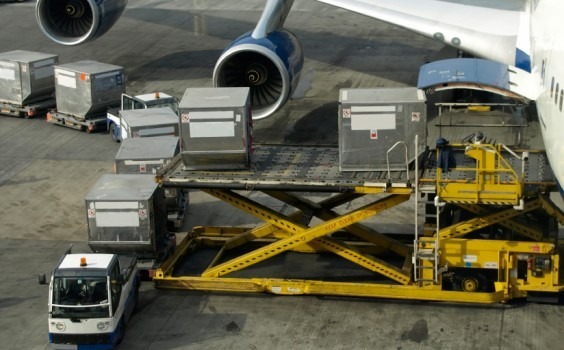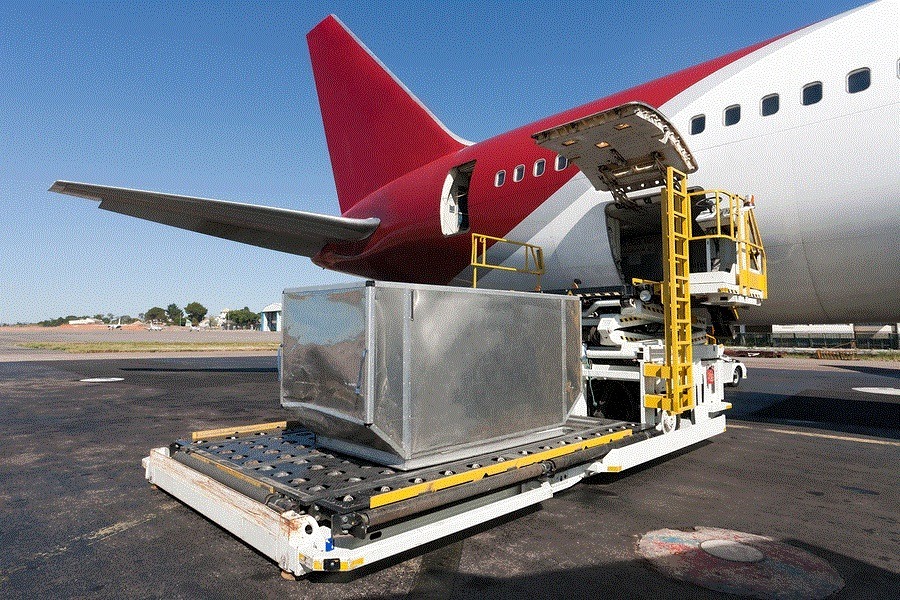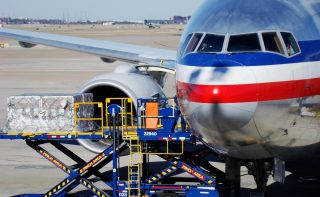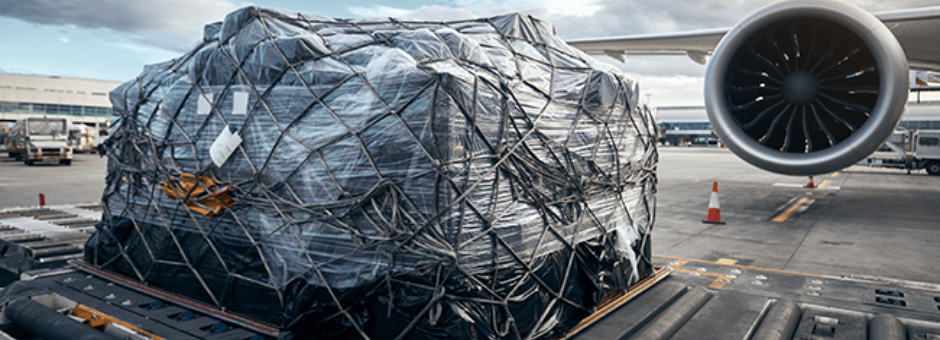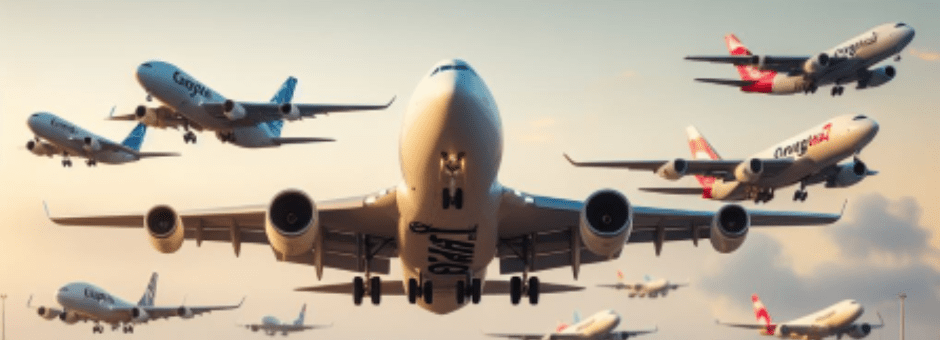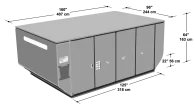Same Day Air Freight | CargoMaster®
The Fastest Way to Move Interstate Air Freight – Same Day Air Freight Australia
Sydney, Melbourne, Brisbane, Adelade, Perth, Darwin
Fast and Reliable Same Day Air Freight Australia
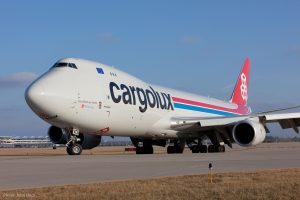 For over 35 years, CargoMaster has been a trusted name in the urgent air freight industry, providing exceptional same day and overnight air freight services across Australia. With over 35 years of professional experience, CargoMaster specializes in time-sensitive air cargo, ensuring your goods reach their destination swiftly and safely. When you choose CargoMaster for your interstate air freight needs, you’re backed by a team of experts dedicated to delivering your cargo on time, every time.
For over 35 years, CargoMaster has been a trusted name in the urgent air freight industry, providing exceptional same day and overnight air freight services across Australia. With over 35 years of professional experience, CargoMaster specializes in time-sensitive air cargo, ensuring your goods reach their destination swiftly and safely. When you choose CargoMaster for your interstate air freight needs, you’re backed by a team of experts dedicated to delivering your cargo on time, every time.
CargoMaster’s comprehensive air cargo services cover every corner of Australia, from bustling urban centers to the most remote regions and mine sites. Our expertise includes handling various types of urgent air freight, from construction equipment and mining machinery to medical supplies and show band equipment. No matter the size or nature of your cargo, CargoMaster partners with the industry’s best airline operators, ensuring your goods are in safe hands.
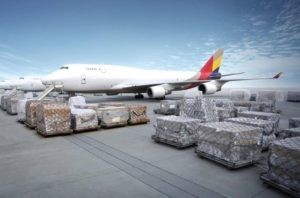 In addition to same day and overnight air freight, CargoMaster offers specialized services, including air freight charter for large and heavy items, as well as assistance with de-stuffing international self-pack shipping containers. Our team is also experienced in handling dangerous goods, providing packaging, identification, and classification services free of charge. For larger air freight needs, we prepare and package dangerous cargo to meet IATA DG standards, ensuring compliance with all regulations.
In addition to same day and overnight air freight, CargoMaster offers specialized services, including air freight charter for large and heavy items, as well as assistance with de-stuffing international self-pack shipping containers. Our team is also experienced in handling dangerous goods, providing packaging, identification, and classification services free of charge. For larger air freight needs, we prepare and package dangerous cargo to meet IATA DG standards, ensuring compliance with all regulations.
CargoMaster operates around the clock, offering same day air freight services 24/7. With a reputation for reliability and speed, our dedicated team of air freight specialists is ready to handle your urgent deliveries. Whether you’re shipping time-sensitive medical equipment or essential industrial parts, CargoMaster’s fast, direct, and deferred domestic air cargo options ensure your freight reaches its destination without delay.
At CargoMaster, we understand the unique challenges of transporting fragile and valuable items. Our air freight services provide the highest level of security, making us the preferred choice for high-value goods. From musical instruments to emergency recovery equipment, we handle all types of cargo with the utmost care and professionalism.
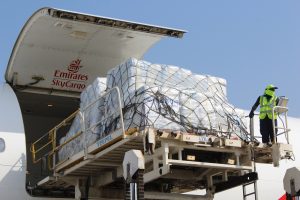 Navigating the complexities of hazardous air freight is made simple with CargoMaster. Our extensive experience with various types of dangerous goods, from solvents and adhesives to compressed gases and dry ice, ensures your cargo is handled safely and efficiently. We adhere to strict regulations and provide expert guidance on the proper documentation and packaging required for hazardous materials.
Navigating the complexities of hazardous air freight is made simple with CargoMaster. Our extensive experience with various types of dangerous goods, from solvents and adhesives to compressed gases and dry ice, ensures your cargo is handled safely and efficiently. We adhere to strict regulations and provide expert guidance on the proper documentation and packaging required for hazardous materials.
Our commitment to excellence extends beyond air freight. CargoMaster also offers de-stuffing services for international self-pack containers and comprehensive solutions for packaging and classifying dangerous air cargo. Our team of DG qualified and accredited personnel ensures your cargo meets all necessary standards for safe transport.
For any questions or to arrange your same day air freight, contact CargoMaster today. Our experienced team is ready to provide you with a personalized quote and ensure your cargo is delivered quickly and securely. Call us at 1300 767 136 and experience the CargoMaster difference.
Frequently Asked Questions
Is there a difference between air cargo and air freight shipping?
In Australia, “air freight” and “air cargo” are used interchangeably, though “air freight” is more common. In the USA, “air cargo” is the preferred term.
Do you have a maximum height for air freight?
Yes, height is crucial for air freight. To be loaded onto domestic aircraft in Australia, your air cargo must be less than 1.6 meters high. If your cargo exceeds this height, contact CargoMaster to explore possible solutions.
How do I calculate the cost of air freight?
The cost of air freight is determined by either the actual weight or the volumetric weight of your cargo, whichever is greater. This involves weighing and measuring the cargo. For precise calculations and a detailed quote, contact CargoMaster.
What are the advantages of air freight?
Air freight offers several benefits, the most significant being its fast transit time. It is also ideal for transporting fragile and valuable items due to its high level of security. This makes air freight the preferred choice for high-value goods.
What are the disadvantages of air freight?
Air freight can be more costly compared to other transportation methods. There are also limitations on the size and weight of the cargo that can be transported by aircraft. Additional documentation is often required, and more items are classified as hazardous cargo.
Is air freight more expensive than sea freight?
Generally, yes. Air freight is more expensive than sea freight in almost all cases due to the speed and security it offers.
What is the average cost of air freight?
There is no standard cost for air freight as prices vary based on several factors, including the size and weight of the cargo, the destination, and the type of service required. For accurate pricing, contact CargoMaster.
What is the cost of air freight per ton?
Air freight costs are calculated per kilogram. To find the per-ton cost, multiply the kilogram rate by 1,000. For detailed pricing, reach out to CargoMaster.
What is the maximum weight for air freight?
The maximum weight for air freight depends on the aircraft type. Wide-body aircraft can accommodate heavier and larger cargo compared to narrow-body aircraft.
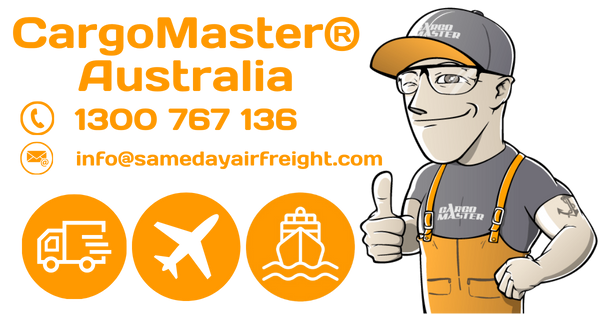 Addition Information (Click the +/- plus/minus symbols to expand/collapse)
Addition Information (Click the +/- plus/minus symbols to expand/collapse)
| City | Country | Airport code |
|---|---|---|
| Adelaide | Australia | ADL |
| Brisbane | Australia | BNE |
| Cairns | Australia | CNS |
| Canberra | Australia | CBR |
| Gold Coast | Australia | OOL |
| Hobart | Australia | HBA |
| Melbourne | Australia | MEL |
| Perth | Australia | PER |
| Townsville | Australia | TSV |
| Mackay | Australia | MKY |
| Sydney | Australia | SYD |
| Karratha | Australia | KTA |
| Kununurra | Australia | KNX |
| Broome | Australia | BME |
| Rockhampton | Australia | ROK |
| Kalgoorlie | Australia | KGI |
| Port Hedland | Australia | PHE |
| Darwin | Australia | DRW |
| Alice Springs | Australia | ASP |
| Launceston | Australia | LST |
| Newman | Australia | ZNE |
| Maroochydore | Australia | MCY |
SIGNIFICANT CHANGES AND AMENDMENTS TO THE 59TH EDITION (2018) The 59th edition of the IATA Dangerous Goods Regulations incorporates all amendments made by the IATA Dangerous Goods Board and includes addenda issued by ICAO to the 2017–2018 edition of the Technical Instructions. The following list is intended to assist the user to identify the main changes introduced in this edition and must not be considered an exhaustive listing. The changes have been prefaced by the section or subsection in which the change occurs. 2—Limitations 2.3—Dangerous Goods Carried by Passengers or Crew 2.3.5.9—Limitations have been adopted on the number of portable electronic devices (PED) and the number of spare batteries for the PED that may be carried by passengers or crew. The limit is a maximum of 15 PED and a maximum of 20 spare batteries. These maximums may be exceeded with the approval of the operator. Table 2.3.A has also been revised to reflect these limits. 2.8—Operator Variations There are a number of additions, deletions and amendments to variations submitted by operators. 3—Classification 3.9.2—This subsection has been restructured to bring in all substances and articles that are assigned to Class 9 with their respective UN numbers and proper shipping names. The substances and articles have then been grouped according to the hazard they pose in transport. 4—Identification 4.4—Special Provisions A70—Which identifies the conditions under which engines may be considered as “not restricted”. The conditions have been revised to require that the shipper provide written or electronic documentation stating that a flushing and purging procedure for flammable liquid powered engines has been followed. A203—Identifies that vehicles powered by an engine powered by both a flammable liquid and flammable gas must be assigned to the entry Vehicle, flammable gas powered. The special provision has been revised to clarify that in this instance the applicable provisions of PI 950(a) must also be met. 5—Packing 5.0.1.5.1—Has been revised to include new restrictions on packages containing lithium batteries, UN 3090 and UN 3480 only, being placed into an overpack with packages containing dangerous goods classified in Class 1 other than Division 1.4S, Division 2.1, Class 3, Division 4.1 or Division 5.1. 5.0.2.11—An additional note has been added to identify that lithium batteries, UN 3090 and UN 3480 only, are not permitted in the same outer packaging with dangerous goods classified in Class 1 other than Division 1.4S, Division 2.1, Class 3, Division 4.1 or Division 5.1. Packing Instructions PI 951—Has been revised to include a requirement that if the vehicle is powered by an engine using both flammable gas and flammable liquid fuels, then the shipper must also meet the relevant provisions of PI 950. PI Y960—A note has been added to reinforce that dangerous goods in PG I are not permitted. PI 965 and PI 968—Text has been added to identify the restrictions on packing lithium batteries (UN 3480 and UN 3090 only) in the same outer packaging with dangerous goods classified in Class 1 other than Division 1.4S, Division 2.1, Class 3, Division 4.1 or Division 5.1. There are also restriction on placing packages containing lithium batteries (UN 3090 and UN 3480 only) into an overpack with packages containing dangerous goods classified in Class 1 other than Division 1.4S, Division 2.1, Class 3, Division 4.1 or Division 5.1. These restrictions apply to Section IA and IB. For Section II, cells and batteries must not be packed in the same outer packaging with other dangerous goods. 7—Marking & Labelling 7.1.5.5.2—Text has been added recommending that the UN number(s) on the lithium battery mark be of a minimum size.
9—Handling 9.3.2—Table 9.3.A and the provisions of 9.3.2 have been revised to introduce segregation requirements for lithium batteries (UN 3480 and UN 3090 only) and dangerous goods classified in Class 1 other than Division 1.4S, Division 2.1, Class 3, Division 4.1 or Division 5.1. This aligns to the changes in 5.0.1.5, 5.0.2.11, PI 965 and PI 968. A note has been added to identify that the segregation of packages and overpacks loaded into ULD and aircraft cargo compartments, while recommended as of 1 January 2018, will not become mandatory until 1 January 2019. Appendix B—In Appendix B.2.2.4 new Cargo IMP codes have been added for UN 3090, Section IA and IB of PI 968—RBM and UN 3480, Section IA and IB of PI 965—RBI. These two new IMP codes facilitate the differentiation of fully regulated lithium batteries (UN 3090 and UN 3480) from those packed with equipment or contained in equipment (UN 3091 and UN 3481), which are currently assigned to RLM and RLI respectively. Appendix D—contact details for competent authorities have been updated. Appendix E—changes have been made to the list of UN Specification Packaging Suppliers (E.1) and the Package Testing Facilities (E.2). Appendix F—the list of Sales Agents (F.2), IATA Accredited Training Schools (F.3—F.5) and IATA Authorised Training Centres (F.6) have been revised. Appendix I—A new appendix has been added to this edition of the DGR to provide the detail of the changes that will come into effect as of 1 January 2019 based on the adoption of the changes arising from the 20th revised edition of the UN Model Regulations as well as the changes that have been agreed to date by the ICAO Dangerous Goods Panel for inclusion into the 2019–2020 edition of the Technical Instructions. These changes include: ● replacement of most instances of the word “risk” by the word “hazard”. The changes reflects the increasing use of safety management systems where “risk” is the likelihood of an event combined with the severity of the outcome, whereas hazard is used to identify the inherent properties. So, for example a substance may have a “subsidiary hazard”, not a “subsidiary risk”. ● significant changes to the provisions for the classification of corrosive substances. These changes reflect the work of the UN Subcommittee with the GHS Subcommittee to better align the classification provisions for transport for Class 8 substances with those for supply and use. ● a new requirement for manufacturers and subsequent distributors of lithium cells or batteries to make available a summary of the UN 38.3 tests. ● new provisions for the classification of articles containing dangerous goods, n.o.s.. This includes twelve new UN numbers, UN 3537 to UN 3548, that have been assigned to articles containing dangerous goods in Classes 2, 3, 4, 5, 8 and 9 and Division 6.1. The details of the provisions that will come into effect in 2019 for air transport have still to be finalised by the ICAO dangerous Goods Panel. ● a number of new and modified special provisions. ● removal of the lithium battery handling label (7.2.4.7). As of 1 January 2019 only the lithium battery mark (7.1.5.5) will be permitted on packages of lithium batteries prepared in accordance with Section IB of PI 965 or PI 968, or Section II of PI 965 to PI 970. REFERENCE MARKS The following symbols placed against an item indicate changes from the previous edition: Symbol—Meaning —Addition of a new item. —Change to an item. —Cancellation of an item. —Additional IATA requirements. —Indicates that the item relates entirely to Radioactive shipments
Please Note: The below list does not describe all types of hazardous air cargo (it is not exhaustive and all encompassing). General items listed below may be found in baggage and possibly have hazards that are not immediately apparent. There are strict laws in relation to lodging of hazardous air cargo and compliance with hazardous air cargo regulations.
Typical examples of hazardous air cargo
Ammunition
Aerosols
Compressed non-flammable gas
Batteries
Breathing Apparatus
Motor Vehicle parts
Chemicals
Dry Ice
Electrical equipment
Diving equipment
Diagnostic specimens
Frozen Embryos
Switches in electrical equipment
Refrigerators (may contain gases or chemicals)
Swimming pool chemicals
Pressurised containers
Engines (contain fuel and that are not cleaned, purged and sealed)
Mining equipment
Magnets
Pressurised containers
Passenger baggage (containing flammable gas or liquid lighter refuel. camping stove cylinders
Photographic Supplies
Expeditionary equipment
Vaccines
Solvents, adhesives
Pesticides
Dental apparatus
Machinery parts
Frozen foods (packed in solid dry ice)
The international community has established a classification system for easy identification of dangerous goods. These goods fall into nine primary classes, and some classes are further divided to address specific risks. Each class/division has a corresponding label that accurately represents the nature of the hazard. These labels must be attached to the package during transport and remain intact throughout the journey. Take a look at the illustrated examples below to understand how these labels effectively communicate the potential dangers.
Under regulations, labels must be clearly visible on the outside of the package and must stay on the package while in transit.
You can often find labels printed on most inner packages such as:
- aerosol cans
- bottles of bleach
- containers of thinners
- tins of paint
- many other products which are available at supermarkets and hardware stores.
Below are the 9 hazard labels for the 9 classes of dangerous goods.
Class 1 Explosives

This includes items such as:
- explosive substances
- pyrotechnic devices
- ammunition
- fireworks
- detonators.
Class 2 Gases

These can be transported as:
- compressed
- liquefied
- refrigerated liquefied
- gas in solution.
This includes aerosols. Class 2 has 3 divisions:
- Division 2.1 – flammable gases such as:
- butane
- propane
- Division 2.2 – non-flammable, non-toxic gases such as:
- oxygen
- liquid nitrogen
- compressed air
- Division 2.3 – toxic gases such as:
- chlorine
- hydrogen sulphide.
Class 3 Flammable liquids

This includes liquids with a boiling point of 35⁰ C or less, or a flash point of 60⁰ C or less such as:
- petrol
- alcohol
- perfumes
- essential oils
- hand sanitiser
- paints.
Class 4 Flammable solids

These are substances that can spontaneously combust and substances, that when they come into contact with water or emit flammable gases. Class 4 has 3 divisions:
- Division 4.1 – flammable solids such as:
- hexamine solid fuel tablets for camping stoves
- self-reactive substances
- desensitised explosives
- Division 4.2 – substances that can spontaneously combust under normal air transport conditions include:
- camphor
- sulphur
- matches
- Division 4.3 – substances that emit flammable gases when they come into contact with water include:
- sodium
- zinc particles
- activated carbon.
Class 5 Oxidising substances and organic peroxides

These substances are not necessarily combustible on their own but can react dangerously with other substances. Class 5 has 2 divisions:
- Division 5.1 – oxidising substances that may not be necessarily combustible, but they may readily yield oxygen and cause other materials to combust, such as:
- hydrogen peroxide
- ammonium nitrate
- potassium chlorate
- sodium nitrate
- Division 5.2 – organic peroxides are thermally unstable and can emit heat and give off harmful or flammable vapours. They can also be liable to explosive decomposition and react dangerously with other substances. Examples are:
- acetyl acetone peroxide
- benzoyl peroxide
- peracetic acid.
Class 6 Toxic and infectious substances

These substances can cause sickness, injury or death if consumed. Class 6 has 2 divisions:
- Division 6.1 – toxic substances that can cause death, injury or to harm human health if swallowed, inhaled or by skin contact, such as:
- chloroform
- arsenics
- cyanides
- cytotoxic waste
- barium compounds
- pesticides
- Division 6.2 – infectious substances that contain or are expected to contain pathogens that can cause disease in humans or animals, including:
- medical or clinical waste
- patient specimens
- genetically modified organisms
- infectious substances
- infected animals.
Class 7 Radioactive materials

These are substances that emit invisible ionising radiation that can be harmful to humans and animals. It can cause objects such as aircraft and equipment to become contaminated if not packaged and handled correctly, such as:
- uranium
- radioactive ores
- isotypes
- radium
- cesium
- x-ray equipment
- medical equipment or parts.
Class 8 Corrosives

These substances can cause irreversible damage if they come into contact with skin and could destroy other freight, or materially damage containers or aircraft. This includes:
- acids
- corrosive cleaners
- battery fluid
- formaldehyde
- hydrofluoric acid.
Class 9 Miscellaneous
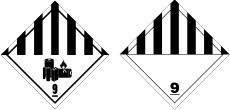
These are substances and articles which, during air transport, present a danger not covered by other classes. There are 2 types of handling labels – 1 for lithium battery shipments, and another for all other miscellaneous dangerous goods. This class includes:
- lithium batteries
- battery powered vehicles
- battery powered equipment
- first aid kids
- environmentally hazardous substances
- dry ice
- magnetised materials
- asbestos.
Handling labels
In addition to hazard labels, trained staff must attach handling labels where needed. Staff must use these 4 handling labels with the appropriate hazard labels:
Cargo aircraft only
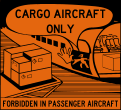
This label is used to show that the load cannot be carried on a passenger aircraft.
Cyrogenics

This label is used on liquefied gases, such as the ones in Class 2.
This way up

This label ensures a load is placed the correct way up and can be used for non-dangerous goods.
Magnetised material

This label ensures that the load is kept away from the aircraft compass detector unit while being loaded and unloaded.
| A2A | Airport-to-airport |
| A2D | Airport-to-door |
| ADV | Advise, Advised, Advising |
| AEA | Association of European Airlines (see the page “Interest Organisations” of this website also) |
| Airline | Company operating aircraft between steady origin and destination airports |
| Airmail | Mail travelling by air |
| Air Operator | Company operating aircraft |
| Airport-to-airport | Transport from an airport of origin to an airport of destination |
| Allotment | Assigned volume on board of a flight / day |
| AOG | Aircraft On Ground ; materials expedited for repair of a grounded aircraft |
| AP | Airport |
| ARR | Arrive, Arrived, Arrival |
| ARR | Also a C2K milestone: ARR = cargo and documents arrived at airport of destination |
| ATA | Air Transport Association (see the page “Interest Organisations” of this website also) |
| ATA | Actual Time of Arrival |
| ATD | Actual Time of Departure |
| Authorisation | The commission to a certain person or body to act on behalf of another person or body ; the person or body can be authorised e.g. to issue air waybills or to collect freight |
| AVI | Live Animal(s) |
| AWB | Air Waybill |
| Backlog | Amount of goods still to be delivered or received and for which the planned or agreed date has expired |
| BAG | Baggage |
| Belly | Lower-deck cargo hold of an aircraft |
| BIG | Outsized cargo |
| Blocked-space agreement | A continuous reservation (allotment) for space at one or more flight / date combinations with an airline |
| Bonded Goods | Goods on which the customs duty has not yet been paid, and which therefore, are under the control of customs; usually in a Bonded warehouse. |
| Bonded warehouse | A depository for goods on which the customs duty has not been paid ; the warehouse proprietor must provide a bond (often in the form of a bank warranty or a mortgage) to the customs authorities as a security for any duties which may not be paid by the customer |
| Booking | Request for reservation of space on a flight/day, (to be) confirmed by the airline |
| Break Bulk Agent | A forwarder breaking the bulk: taking care of the unpacking and sorting of goods after the flight |
| Breakdown List | List of shipments carried in one consolidation (see also: Consolidation Manifest) |
| Broker | Person who acts as an agent or intermediary in negotiating contracts ; sometimes refers to a forwarder role |
| Bulk Cargo | Loose cargo not loaded on an ULD |
| C2K | Cargo 2000 (see the “Cargo 2000” page of this website) |
| Cargo Aircraft | Aircraft built with the purpose of carrying nothing else than cargo |
| Cargo assembly | The separate reception of parcels or packages and the holding of them for later dispatch as one consignment ; consolidator role |
| Cargo Disassembly | The separation of one or more of the parcels or packages that are part of a consignment for further distribution ; break bulk role |
| Carriage | Transport ; the process of conveying cargo from one point to another |
| Carrier | The party responsible for transport of goods from one point to another, this can be for example an airline or a forwarder (as a NVOCC) |
| CASS | Cargo Accounts Settlement System |
| CAO | Cargo Aircraft Only |
| CC | Charges Collect ; pay at moment of collection of the goods |
| CCS | Cargo Community System ; information system integrating the communication between air cargo parties at an airport |
| Certificate of Origin | A certificate proving the country of original production of goods ; used for customs declaration purposes |
| Charges collect | Charges as stated on the air waybill to be collected from the consignee |
| Charges prepaid | Charges as stated on the air waybill to be collected from the shipper |
| Claim | A written complaint about the execution of a contract of transportation by a carrier, combined with a demand for financial compensation |
| Classifying | Assigning the right import classification number to goods as part of the customs declaration process |
| CLR | Clear |
| CNEE | Consignee |
| COLL | Collect, Collected, Collecting |
| COMAT | Company Material (non revenue cargo) |
| Combi | Combi Aircraft, combining transport of passengers and cargo on the main-deck |
| Commodity | Indication of the type of goods ; commodities are coded according to the harmonised system |
| Commodity code | Code used in the Harmonised System for the classification of goods, which are most commonly produced and traded |
| Complaint | An official statement from a customer to a carrier about his unhappiness with the service or operation of the service provider |
| Consignee | The person or company that is physically and administratively responsible for accepting the goods at final delivery |
| Consolidation | A collection of shipments belonging to different shippers travelling to one destination or area to be distributed to several consignees |
| Consolidation Manifest | List of shipments carried in one consolidation |
| Consolidation Rates | Rates as given by a consolidator / forwarder |
| Consolidator | A forwarder consolidating shipments before a flight ; these shipments belonging to different shippers and travelling to one destination or area in order to be distributed to several consignees after the flight |
| Courier | Company that carries envelopes and parcels up to 75 kg from door to door ; air transport is generally outsourced to airlines |
| Courier Rates | Rates as given by a courier |
| CPTY | Capacity |
| CRN | Customs Release Note |
| Customs Agent/Broker (Certified) | Party certified to handle the customs clearance on account of importers / exporters |
| Customs invoice | (Pro forma) Invoice for import declaration (customs and statistics) purposes, stating the commercial price, added with the costs for freight, insurance and packing etc., terms of delivery and payment |
| Customs value | Value of goods to be imported for import declaration (customs and statistics) purposes |
| D2A | Door-to-airport |
| D2D | Door-to-door |
| Dangerous Goods | Goods that can be hazardous for health, flight-safety or materials |
| DAP | A C2K key performance indicator: DAP = Delivered As Promised (NFD in full and on time statuses are achieved) |
| DEP | A C2K milestone: DEP = cargo and documents departed at airport of origin |
| DEPT | Department |
| DG | Dangerous Goods |
| DGR | Dangerous Goods Regulations (IATA) |
| Dimensional Weight (Conversion) | Concept adopted by the transportation industry worldwide as a uniform means of establishing a minimum charge for the cubic space a package occupies ; the volume is converted into a (higher) weight / price class |
| DIMS | Dimensions |
| DIP | Diplomatic mail |
| DLV | Deliver, Delivered, Delivering |
| DLV | Also a C2K milestone: DLV = cargo and documents delivered to customer (forwarder) |
| DOCS | Document(s), Documentation |
| Domestic transport | Transport within a country |
| Door-to-door | Transport from an initial shipper’s house address to a final consignee’s house address |
| Duty | Tax imposed on goods imported from another country |
| EDI | Electronic Data Interchange |
| EDIFACT | Electronic Data Interchange For Administration, Commerce and Transport ; a specific EDI protocol |
| e-Freight | Electronic freight documents project from IATA ; e-Freight aims to take the paper out of the air cargo supply chain and -processes and replace it with cheaper, more accurate and more reliable electronic messaging ; facilitated by IATA, the project is an industry-wide initiative involving carriers, freight forwarders, ground handlers, shippers and customs authorities |
| Electronic Data Interchange | The interchange of electronic data, structured following an agreed protocol, between the automated information system of different parties |
| Embargo | An embargo on a certain kind of goods means these goods will not be transported by the airline, often for flight-safety reasons |
| Equipment | Materials needed to handle or transport goods |
| ESC | European Shippers’ Council (see the page “Interest Organisations” of this website also) |
| ETA | Estimated Time of Arrival |
| ETD | Estimated Time of Departure |
| Expediting | Forwarding goods (in less than the normal lead time) |
| Expeditor | Forwarder |
| FAK | Freight All Kinds |
| FAK-Rates | Rates for Freight All Kinds |
| FAP | A C2K key performance indicator: FAP = Flown As Planned (the complete shipment has flown at or before the last planned flight with a maximum 12 hour delay) |
| FCL | Full Container Load |
| FDCA | Found Cargo |
| FFM | Freight Forwarding Message (electronic) |
| FIATA | International Federation of Freight Forwarders Associations (see the page “Interest Organisations” of this website also) |
| FLT | Flight |
| Forwarder | Company specialized in providing door-to-airport transport, arranging connecting air transport and/or airport-to-door transport for parcels and consolidations > 75 kg or up to anything that fits in an aircraft ; the air transport is generally outsourced to airlines and sometimes aircraft operators or air charter companies |
| Forwarder network | A network existing of different smaller to medium sized forwarding companies all over the world working together |
| Freighter | Aircraft built with the purpose of carrying nothing else than cargo |
| FSU | Freight Status Update |
| Fuel Surcharge | Surcharge added to the cargo rate to cover the additional costs of increasing fuel-prices ; these will generally follow a certain index |
| Full charter | Chartering the full available volume of an aircraft or flight/day |
| Full Container Load | Container fully loaded, generally with goods belonging to one party |
| Full freighter | Aircraft built with the purpose of carrying nothing else than cargo |
| FWB | Electronic air waybill message |
| FWB | Also a C2K milestone: FWB = the shipment is booked at the airline, next an electronic air waybill is generated by agent (forwarder) ; this creates the so-called route map in C2K in which all the steps are followed |
| FYI | For Your Information |
| General Cargo Rates | Rates for all different kinds of cargo, not falling into a specific handling and/or rate category |
| GSA | General Sales Agent |
| GSF | Global Shippers Forum (see the page “Interest Organisations” of this website also) |
| Handling Agent | Agent handling the ramp and/or warehouse cargo operation for an airline |
| Harmonised System | A numeric multi purpose system for the classification of goods with its six digits covering about 5000 descriptions of the products or groups of products most commonly produced and traded, designed for customs purposes, but can also be used for statistics, transport purposes, export, import and manufacturing; the international convention on the HS was established under auspices of the World Customs Organisation in 1983 |
| Haulage | Inland transport of cargo |
| Haulier | Road carrier |
| HEA | Heavy Cargo |
| HAWB | House Air Waybill |
| House Air Waybill | The shipment contract between the end-customer and the forwarder (see the page “Forwarding Out” of this website for further purposes and explanation) |
| Hub | Central point in a transport system or network |
| HUM | Human remains |
| HWB | House Waybill |
| IATA | International Air Transport Association (see the page “Interest Organisations” of this website also) |
| IATA-Agent | An IATA certified agent |
| ICAL | Inbound Cargo Action List |
| ICAO | International Civil Aviation Organisation (see the page “Interest Organisations” of this website also) |
| ICE | Dry Ice Shipment |
| IN | Inches |
| Inco terms | Internationally agreed set of standard delivery terms |
| Integrator | Carrier integrating different modes of transport to form a door-to-door transport or supply chain ; this term mostly refers to the large international express companies who’s core business is to carry envelopes and parcels up to 75 kg, often overnight or even same day |
| Intermodal Transport | The movement of cargo in a supply chain by more than one mode of transport ; for example road/air or sea/air transport |
| INV | Invoice |
| ISA | If Space Available |
| KG | Kilos |
| L/C | Letter of Credit |
| LCL | Less than Container Load |
| Less than Container Load | Container partly filled with goods from one party, or an amount of goods that is not sufficient to fill one container and will therefore likely be consolidated |
| LHO | Living Human Organs / Blood |
| License, import/export | Governmental permit to import / export certain goods under certain conditions |
| Line item | Order line, each line on a packing list or invoice to be declared for customs |
| Load factor | The extent to which the aircraft (weight-, volume-, ULD-) capacity is efficiently utilized (to generate profit) |
| LOC | Location |
| Loose cargo/shipments | Cargo / shipments not loaded on an ULD |
| Lower Deck | The (cargo) deck below the main deck or upper deck of an aircraft |
| LT | Local Time |
| Main deck | Upper deck ; the (cargo) deck above the lower deck of an aircraft |
| Manifest, flight | Document listing the air waybills and a specification of the related goods carried on a flight |
| Master Air Waybill | The shipment contract between the forwarder and the airline (see the page “Forwarding Out” of this website for further purposes and explanation) |
| MAWB | Master Air Waybill |
| MFST | Manifest |
| Minimum Rate | Rate to cover the basic costs of carrying a shipment |
| MSG | Message(s) |
| Network Forwarder | A large forwarding company with worldwide branches |
| NFD | A C2K milestone: NFD = cargo and documents ready for pick-up at airline (handler), the customer (forwarder) is notified |
| NND | Notice of Non Delivery |
| NON-IATA | Airline or agent that is not a member of IATA |
| Nose loading | Loading cargo through the cargo door in the nose of an aircraft |
| Notify address | Address of a party other than the consignee to be notified of arrival of the goods |
| Notify party | Party other than the consignee to be notified of arrival of the goods |
| NOTOC | Notification To Captain ; list for the captain of the aircraft with goods carried on board |
| N-Rates | Rates for shipments with weights up to 45 kg |
| NVOCC | Non Vessel Operating/Owning Cargo Carrier ; in case of Air Cargo a Carrier (e.g. a Forwarder or Consolidator) who issues Air Waybills for the carriage of cargo on aircraft which he does not operate or own |
| OAG | Official Airlines Guide |
| OB | On Board |
| Oversized Cargo | Cargo that exceeds the dimensions of an ULD |
| Package | Packed piece of cargo |
| Packing list | A list for customs declaration and consignment purposes stating number and kinds of packages being shipped, totals of gross, legal, and net weights of the packages, marks and numbers on the packages, contents and part-/serialnumbers |
| Pallet | A (standardized) platform on which goods can be stacked for transport or warehouse handling purposes |
| Pallet, aircraft | A (standardized) platform on which goods can be stacked for air transport purposes |
| Pallet net | A net used to secure the cargo on the aircraft pallet |
| Parcel | Package |
| Part charter | Chartering of a part of the available volume on an aircraft or flight/day |
| Part shipment | Part of a shipment that travels on a different flight and/or day than the rest of the shipment due to available capacity with the airline |
| PAX | Passenger(s) |
| Payload | The (cargo) load that can be carried by an aircraft (to generate revenue) |
| PC | Piece(s) |
| PER | Perishable Cargo |
| PFI | Pro Forma Invoice |
| POA | Proof Of Acceptance ; legal proof a shipment has been accepted by a party |
| POD | Proof Of Delivery ; legal proof a shipment has been delivered by a party |
| POD | Place Of Delivery |
| PP | Charges Prepaid |
| PPD | Prepaid |
| Pre-alert | Message stating the current and or expected status of the goods |
| Principal | The customer ordering the transport or related services |
| PSH | Part Shipment |
| QNTY | Quantity |
| Q-Rates | Rates with a quantity discount |
| RCF | A C2K milestone: RCF = cargo has arrived in the cargo bay at final destination ; cargo and airwaybill are administratively received in the system |
| RCPT | Receipt, Reception |
| RCS | A C2K milestone: RCS = cargo and documents are received ‘Ready For Carriage’ and accepted by airline (handler) |
| Ready For Carriage | (By Air) The goods are correctly packed and labeled, and customs cleared, with the right documents attached |
| Ready For Transport | (By Road) The goods are correctly packed and labeled, with the right documents attached |
| RFC | Ready For Carriage |
| RFT | Ready For Transport |
| Routing | The path that is (to be) followed by the goods from shipper to consignee |
| RUSHR | Rush Reply |
| SASPO | As Soon As Possible |
| SAWB | Substitute Air Waybill |
| Security Surcharge | Surcharge added to the cargo rate to cover the additional costs of the increasing number of security checks and related administration that are legally required by the authorities |
| Shipper | The person or company that is physically and administratively responsible for shipping the goods ; for an airline in most cases a forwarder will be the shipper, for a forwarder the shipper is a third party, for example a trading company, a manufacturer, etc. |
| Shipper’s Letter of Instruction | Document issued by the shipper to instruct and authorize the forwarder to forward and declare goods on his behalf ; contains all shipment details needed to facilitate these services |
| SHPMNT | Shipment |
| Side loading | Loading cargo through a cargo door in the side of an aircraft |
| Skid | Pallet |
| S/L | Short Loaded |
| SLI | Shipper’s Letter of Instruction |
| SSPD | Short Shipped ; stayed behind |
| TACT | The Air Cargo Tariff ; publication of official airline tariffs |
| TBA | Time Before Arrival |
| TBD | Time Before Departure |
| TEMP | Temperature |
| TIACA | The International Air Cargo Association (see the page “Interest Organisations” of this website also) |
| TILNA | Tilting Not Allowed |
| TILTA | Tilting Allowed |
| Time Slot | The agreed time to collect or deliver goods |
| Tonne Kilometer | One tonne (1000 kg or 2204.6 lb) metric flown one kilometer ; productivity indicator |
| TRA | Transit |
| Tracing | Retrieving (information on) the status of goods and documents |
| Tracking | Regular checking on the status of goods and documents |
| Track & Trace | Automated regular retrieval of (information on) the status of goods and documents and checking these against the agreed norms |
| Transfer cargo | Transfer of cargo from one flight to another |
| Transito / Transit cargo | Transfer of cargo from one flight to another |
| TRM | Transfer Manifest |
| TTL | Total |
| ULD | Unit Load Device |
| ULD, contoured | Unit Load Device shaped to exactly fit in an aircraft |
| UNACC | Unaccompanied |
| Unit Load Device | Standardized air cargo loading equipment (pallet, container) |
| Upper deck | Main deck ; the (cargo) deck above the lower deck of an aircraft |
| VAL | Valuable cargo |
| VAT | Value Added Tax |
| VOL | Volume |
| Volume charge | Air transport charge based on the volume of goods instead of the actual weight (see “Dimensional Weight” and “Weight charge” also) |
| VUN | Vulnerable cargo |
| Weight charge | Air transport charge based on the actual weight of the goods (see “Dimensional Weight” and “Volume charge” also) |
| Weight & Balance | Management of the weight and allocation of cargo, passengers and fuel for a flight |
| W/H | Warehouse |
| XPS | Priority Small Package |
| XS | In Excess |
| Yield management | The process of maximising the contribution (revenue) of the (transport & handling) network, equipment, infrastructure and resources |
ULDs are considered an aircraft part and are the only aircraft parts that can be removed from the aircraft and be returned after being handled by unregulated operators, ULD’s are considered to directly contribute to flight safety.
Types Of Unit Load Devices Used In Australia
AKE Container
Type: AKE CONTAINERATA Code: LD3
Internal Volume: 152 cu. ft. 4.3 mc
Weight Limit: 1,588 kg
Loadable Aircraft Type: 747, 747F, 777, Airbus
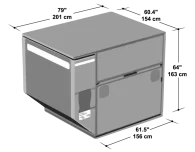 AAU Container
AAU Container
Type: AAU CONTAINER
ATA Code: LD29
Internal Volume: 505 cu. ft. 14.3 mc
Weight Limit: 4,626 kg
Loadable Aircraft Type: 747, 747F
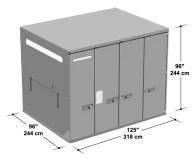 ALF Container
ALF Container
Type: ALF CONTAINER
ATA Code: LD6
Internal Volume: 310 cu. ft. 8.78 mc
Weight Limit: 3,175 kg
Loadable Aircraft Type: 747, 747F,777, Airbus
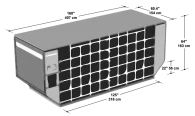 AMA Container
AMA Container
Type: AMA CONTAINER
ATA Code: M1
Internal Volume: 621 cu. ft. 17.58 mc
Weight Limit: 6,804 kg
Loadable Aircraft Type: 747F
 AMF Container
AMF Container
Type: AMF CONTAINER
Internal Volume: 516 cu. ft. 14.6 mc
Weight Limit: 5,035 kg
Loadable Aircraft Type: 747,747F, 777, Airbus
P1P_PAG Pallet
Type: PLA PALLET
Size: Base: 60.4″x 125″, Height: 64″
Weight Limit: 3,175kg
Loadable Aircraft Type: 747, 747F, 777, Airbus
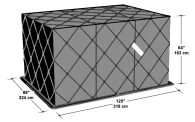 PEB Container
PEB Container
Type: PEB CONTAINER
Size: Base: 53″ x 88″, Height: 84″
Weight Limit: 1,800kg
(B-HIH -1,300 KG)
Loadable Aircraft Type: 747F
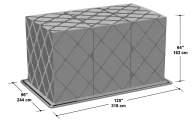 PLA Pallet
PLA Pallet
Type: PLA PALLET
Size:
Base: 60.4″x 125″
Height: 64″
Weight Limit: 3,175kg
Loadable Aircraft Type: 747, 747F, 777, Airbus
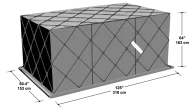 PMC_PQP_P6P Pallet
PMC_PQP_P6P Pallet
Type: PMC, PQP, P6P PALLET
Size: Base: 96″ x 125″
Weight Limit: 5,035 kg (LD), 6,804 kg (MD)
Loadable Aircraft Type: 747, 747F, 777, Airbus
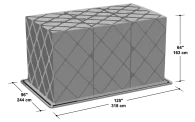 RKN Container
RKN Container
Type: RKN CONTAINER
ATA Code: LD3
Internal Volume: 125.41 cu. ft. 3.55 mc
Weight Limit: Weight: 1,588 kg
Loadable Aircraft Type: 747, 747F, 777, Airbus
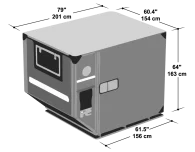 VZA_VRA
VZA_VRA
Size: Fitted on PGA 20 ft. Pallet
Max Width for Lower Car: 81″/ 205 cm
Max Centre Height for Lower Car: 59″/ 150 cm
Max Wheel Base: 312 cm
Weight Limit: 2,500 kg(Upper Car)
9,300 kg c(Max Gross Weight of Pallet)
Loadable Aircraft Type: 747F Upper Deck
A wide variety of aircraft available for international air cargo.
AIRBUS A330-200
Utilised on domestic routes by Qantas
The A330-200, will uplift approx 14 ton or 61 cubic meters
(subject to weather conditions)
AIRBUS A330-300
Utilised by Qantas on domestic air freight routes
The A330-300, will uplift approx 15 ton or 80 cubic meters
(subject to weather conditions)
AIRBUS A320
Utilised by Qantas on domestic routes
The A320 will uplift 1 ton or approx 3 cubic meters
(subject to weather conditions)
AIRBUS A321
The A321 will uplift 3 ton or 10 cubic meters.
AIRBUS A330-800
The A330-800 will uplift 20 ton or 68 cubic meters.
BAE 146-300 FREIGHTER (Quiet trader)
The BAE 146 (Quiet trader as it is known)
Will uplift approx 10 ton or 80 cubic meters.
Boeing B737-300 Freighter
The 737 freighter will uplift approx 17 ton or 130 cubic meters.
Boeing B737-800
The 737-800 will uplift approx 3.5 ton or 30 cubic meters.
Boeing B767-300 Freighter
The 767 freighter will uplift 56 ton and 320 cubic meters.
Boeing B787-9
The 787-9 will uplift approx 18 ton or 96 cubic meters.
INCOTERMS are standard trade terms most commonly used in international freight contracts for sale of goods. It is essential that you are aware of your terms of trade prior to shipment.
EXW – EX WORKS (… named place of delivery)
The Seller’s only responsibility is to make the goods available at the Seller’s premises. The Buyer bears full costs and risks of moving the goods from there to destination.
FCA – FREE CARRIER (… named place of delivery)
The Seller delivers the goods, cleared for export, to the carrier selected by the Buyer. The Seller loads the goods if the carrier pickup is at the Seller’s premises. From that point, the Buyer bears the costs and risks of moving the goods to destination.
CPT – CARRIAGE PAID TO (… named place of destination)
The Seller pays for moving the goods to destination. From the time the goods are transferred to the first carrier, the Buyer bears the risks of loss or damage.
CIP– CARRIAGE AND INSURANCE PAID TO (… named place of destination)
The Seller pays for moving the goods to destination. From the time the goods are transferred to the first carrier, the Buyer bears the risks of loss or damage. The Seller, however, purchases the cargo insurance.
DAT – DELIVERED AT TERMINAL (… named terminal at port or place of destination)
The Seller delivers when the goods, once unloaded from the arriving means of transport, are placed at the Buyer’s disposal at a named terminal at the named port or place of destination. “Terminal” includes any place, whether covered or not, such as a quay, warehouse, container yard or road, rail or air cargo terminal. The Seller bears all risks involved in bringing the goods to and unloading them at the terminal at the named port or place of destination.
DAP – DELIVERED AT PLACE (… named place of destination)
The Seller delivers when the goods are placed at the Buyer’s disposal on the arriving means of transport ready for unloading at the names place of destination. The Seller bears all risks involved in bringing the goods to the named place.
DDP – DELIVERED DUTY PAID (… named place)
The Seller delivers the goods -cleared for import – to the Buyer at destination. The Seller bears all costs and risks of moving the goods to destination, including the payment of Customs duties and taxes.
MARITIME TERMS
FAS – FREE ALONGSIDE SHIP (… named port of shipment)
The Seller delivers the goods to the origin port. From that point, the Buyer bears all costs and risks of loss or damage.
FOB– FREE ON BOARD (… named port of shipment)
The Seller delivers the goods on board the ship and clears the goods for export. From that point, the Buyer bears all costs and risks of loss or damage.
CFR– COST AND FREIGHT (… named port of destination)
The Seller clears the goods for export and pays the costs of moving the goods to destination. The Buyer bears all risks of loss or damage.
CIF – COST INSURANCE AND FREIGHT (… named port of destination)
The Seller clears the goods for export and pays the costs of moving the goods to the port of destination. The Buyer bears all risks of loss or damage. The Seller, however, purchases the cargo insurance.
Professional Logistics services offered by CargoMaster
Air freight consolidation
Air freight packers
Project air freight
Air freight World-wide
Popular Air Cargo Destinations
Thank-you for contacting us, it’s great that you have selected our contact us page, we appreciate the opportunity, if your shipment relates to air freight or less than a container load sea freight, please include the weight and dimensions of each piece in your request. We look forward to working with you, please feel free to call at any time.
Call: 1300 767 136
|
|
 ®
® 